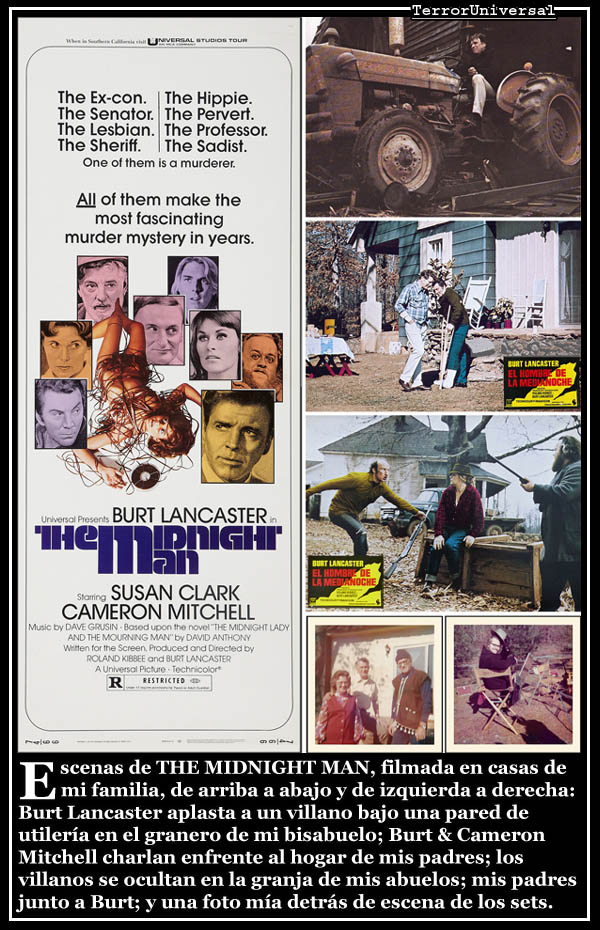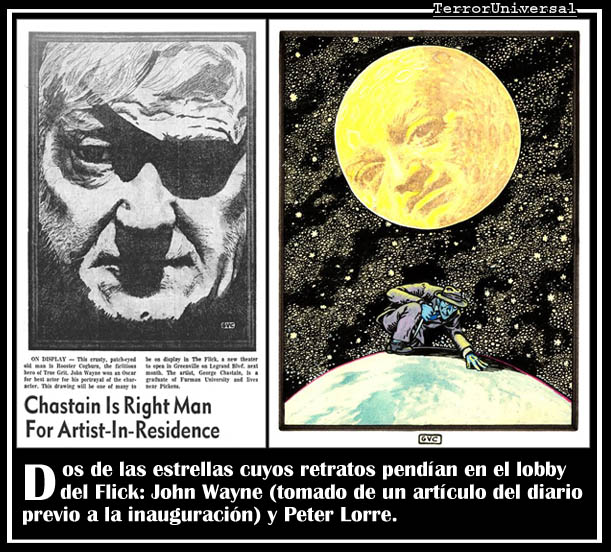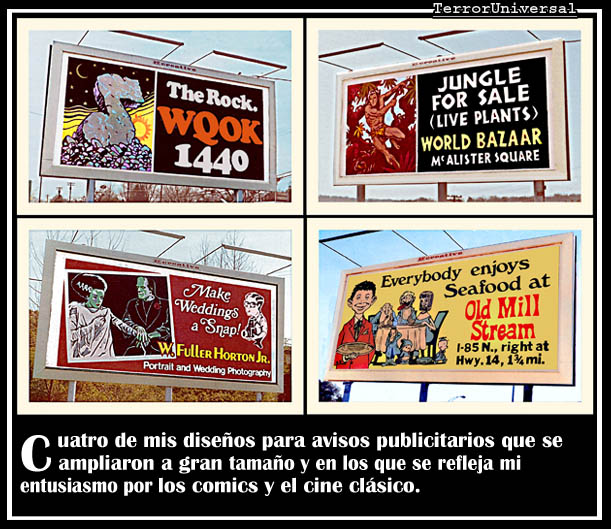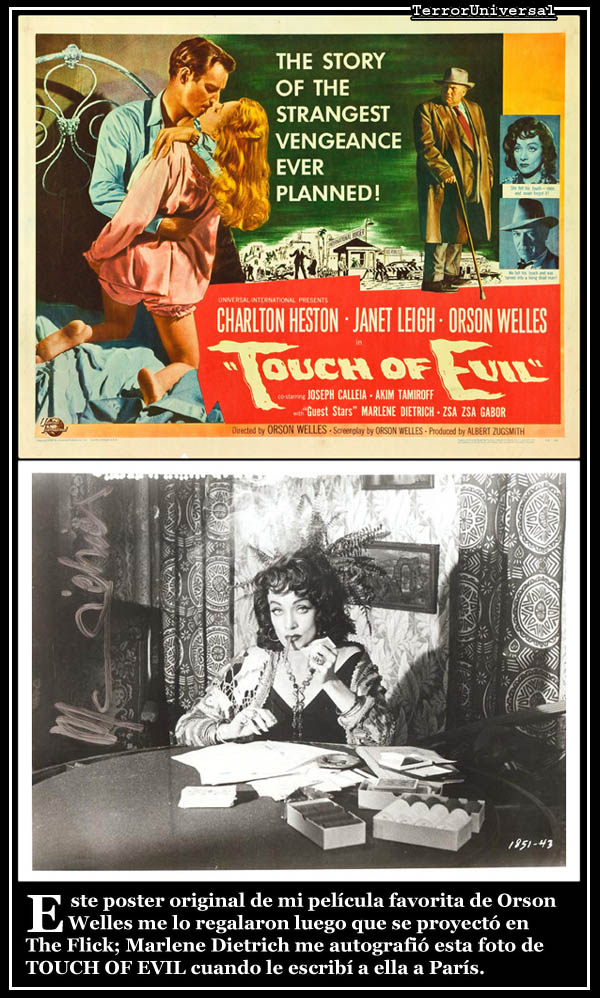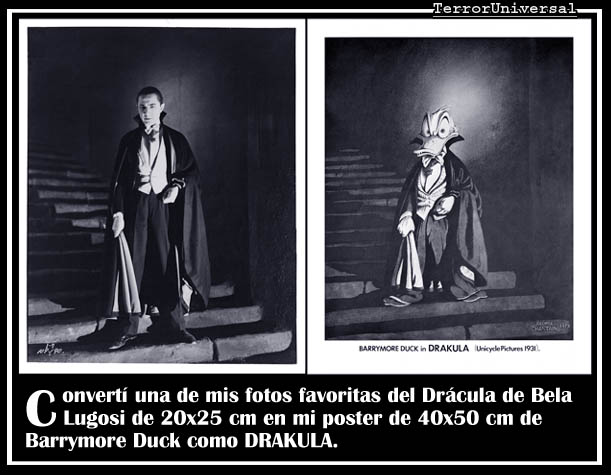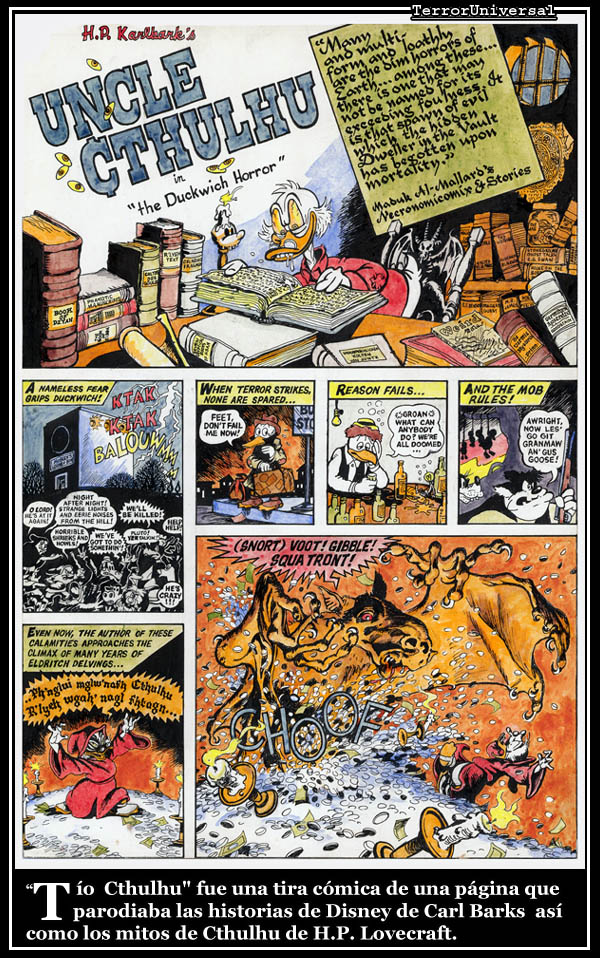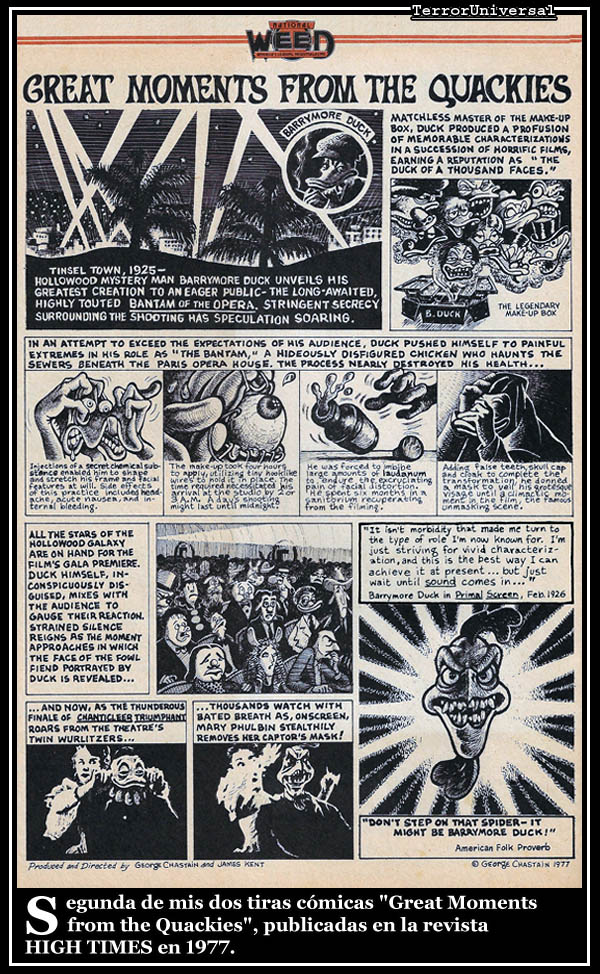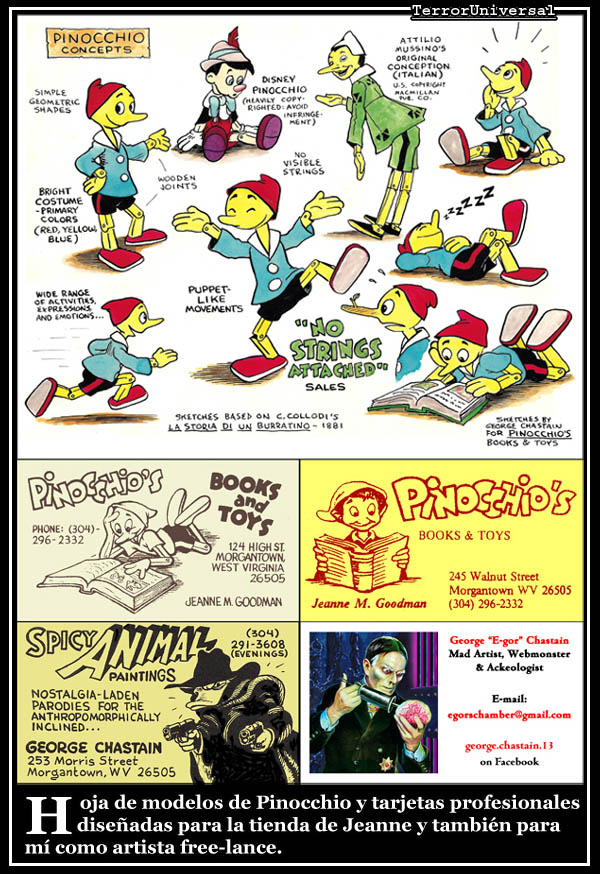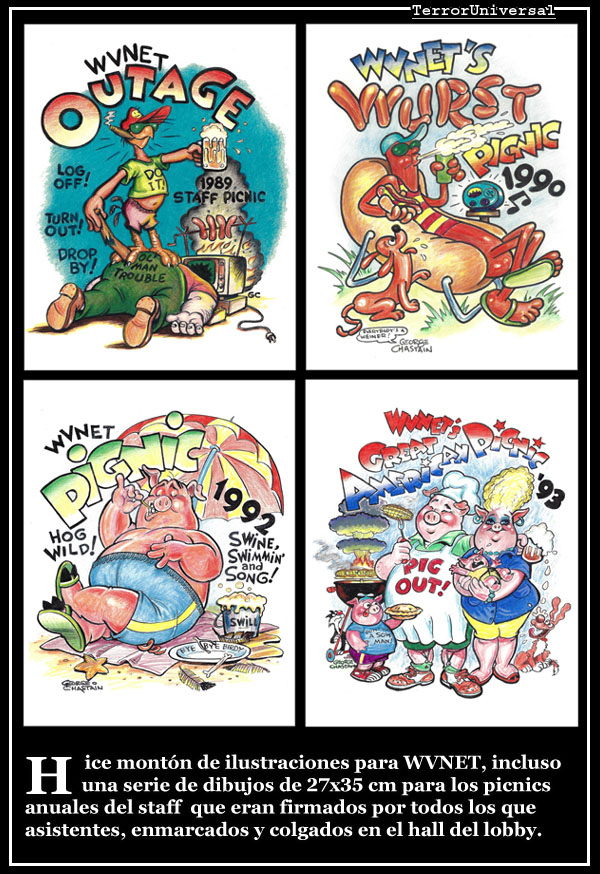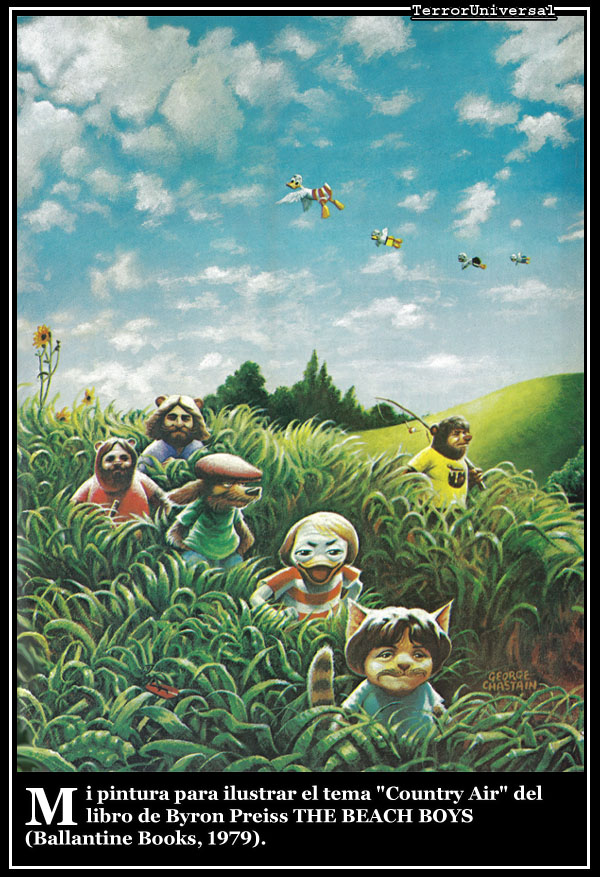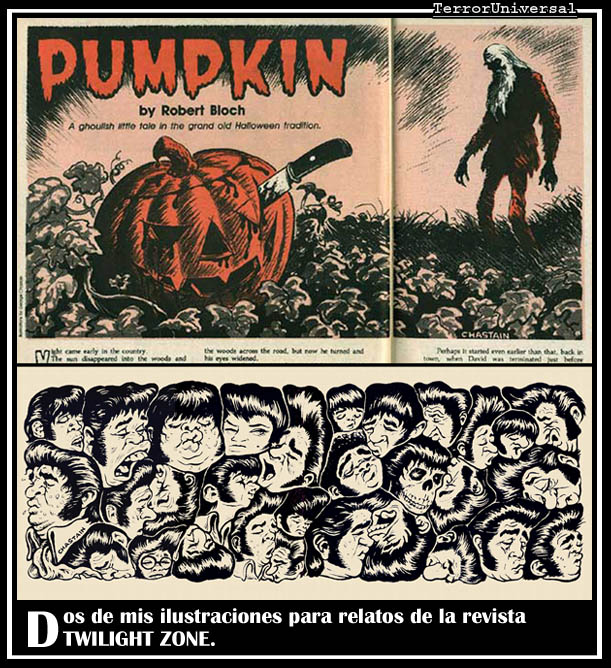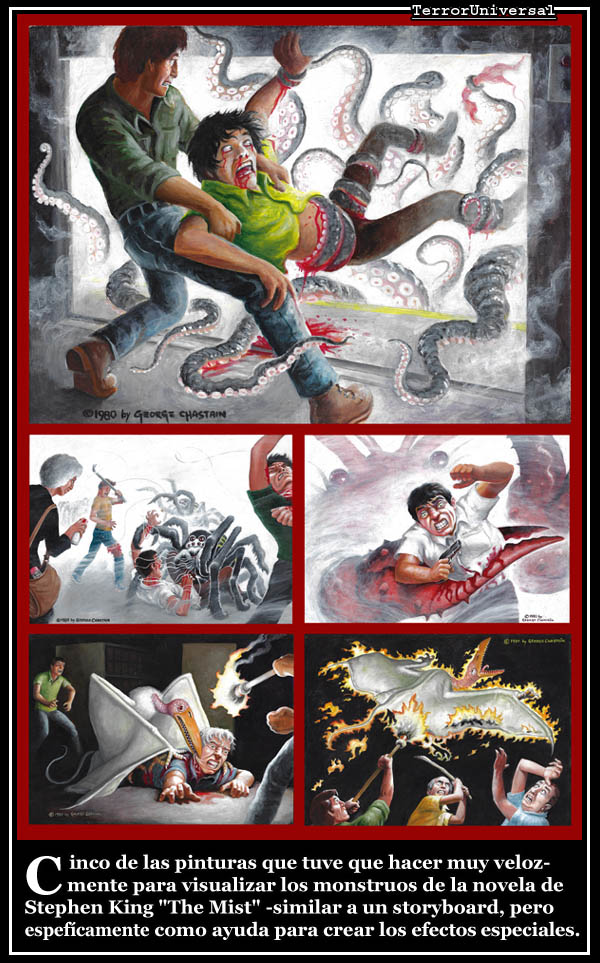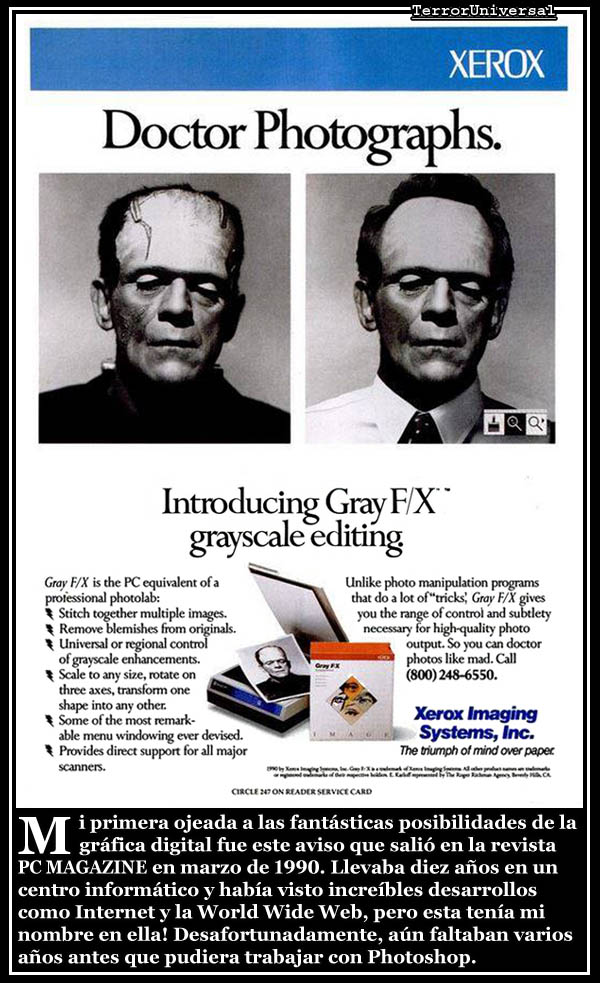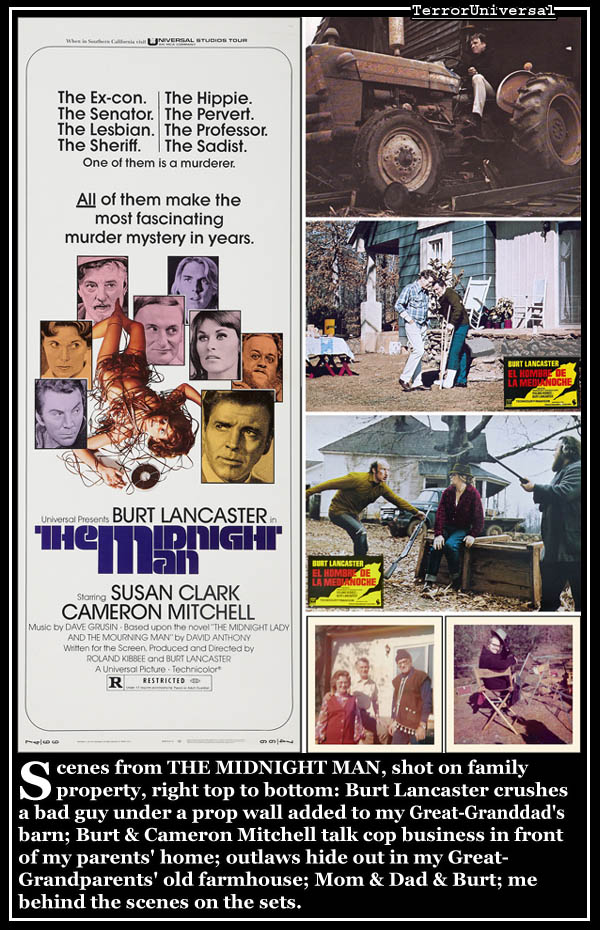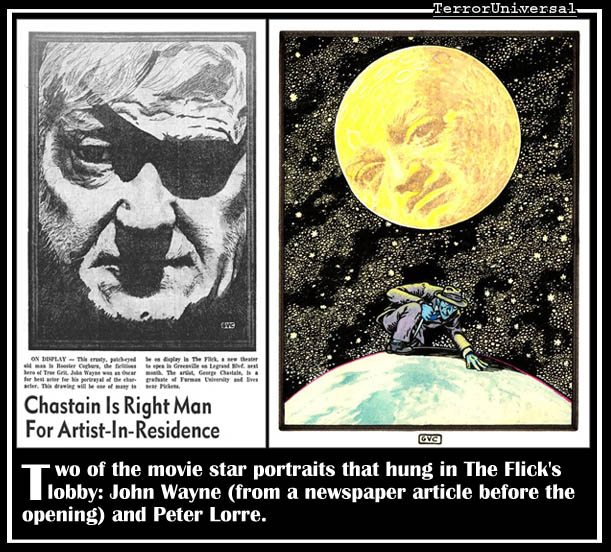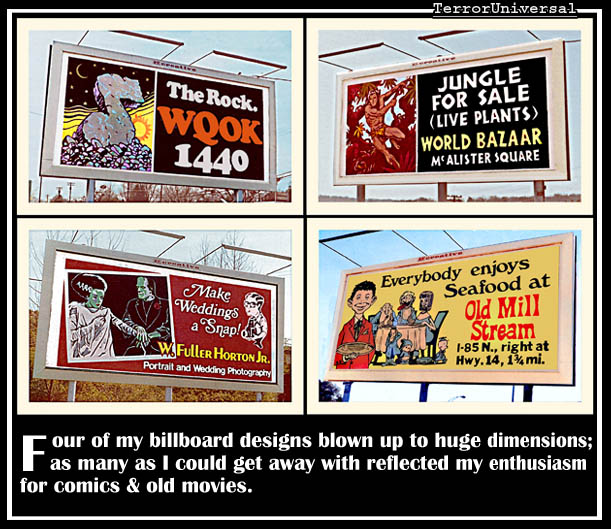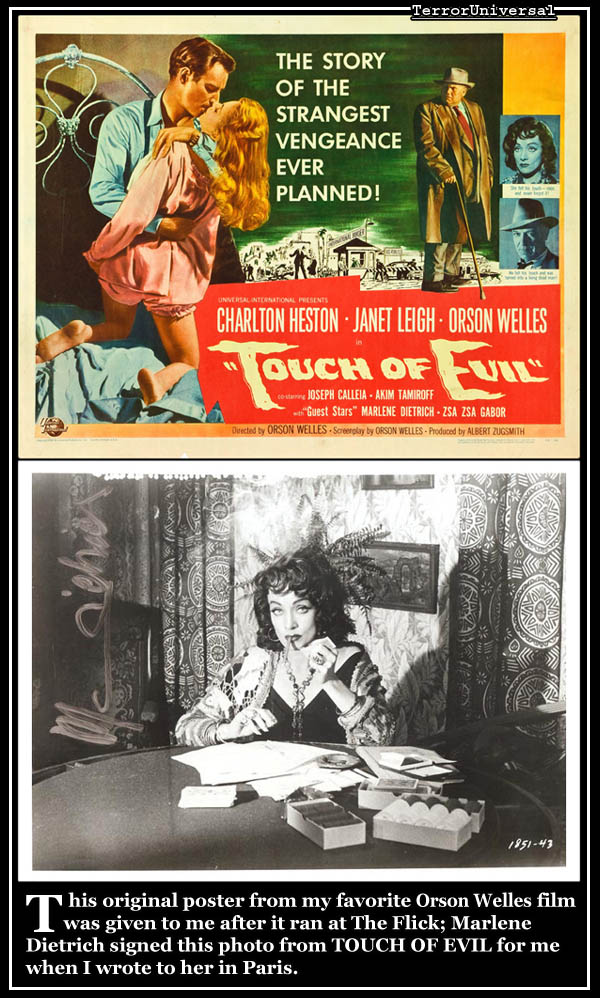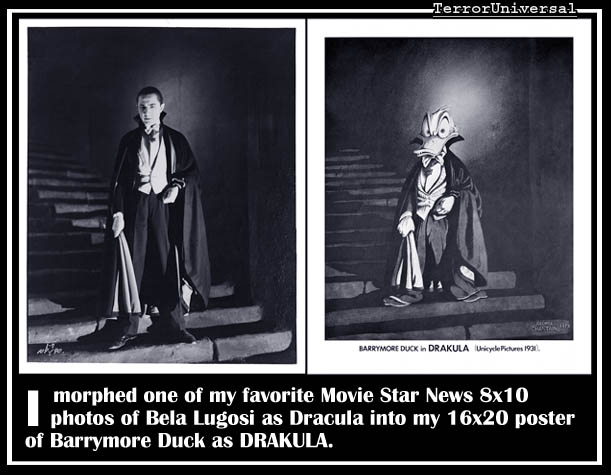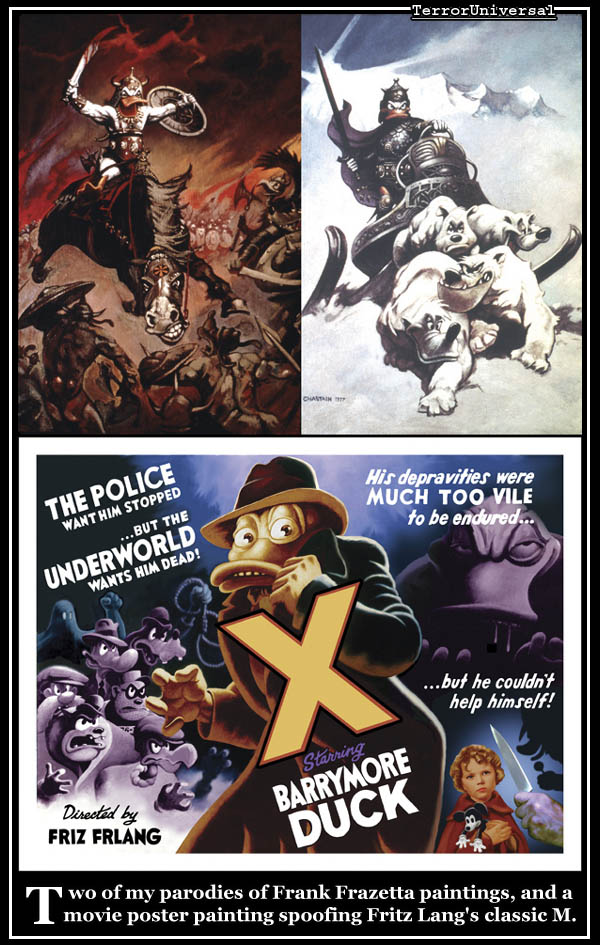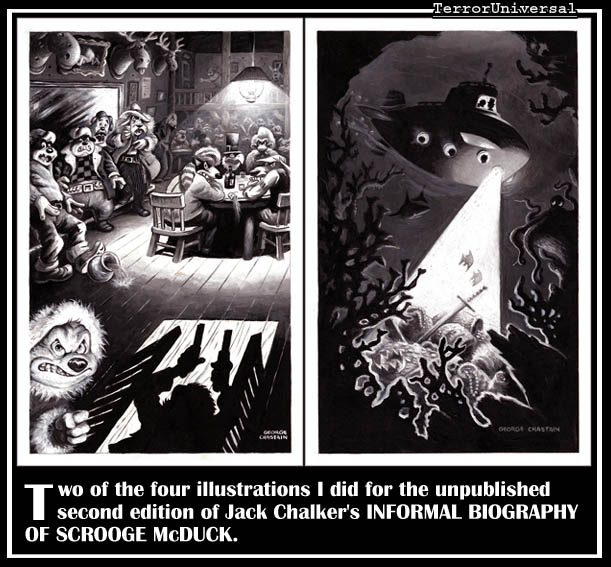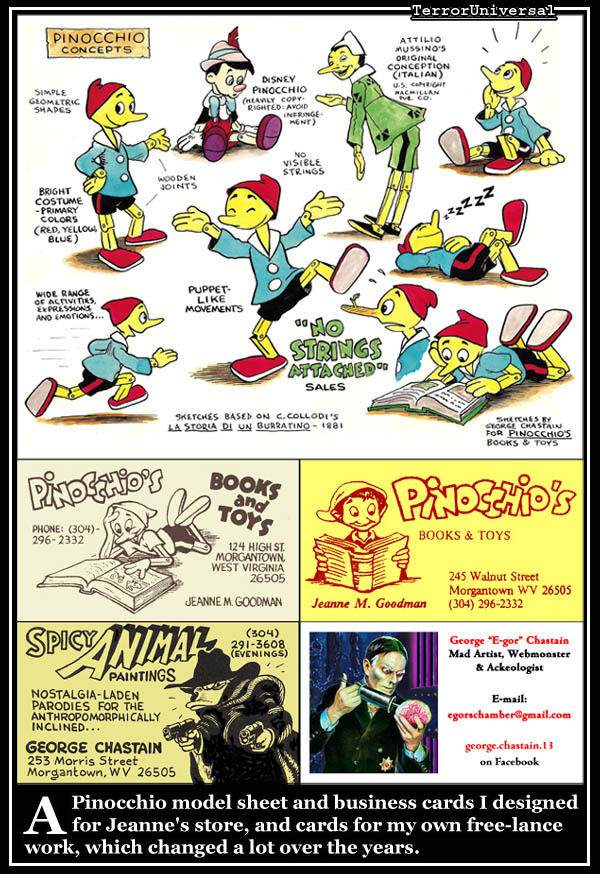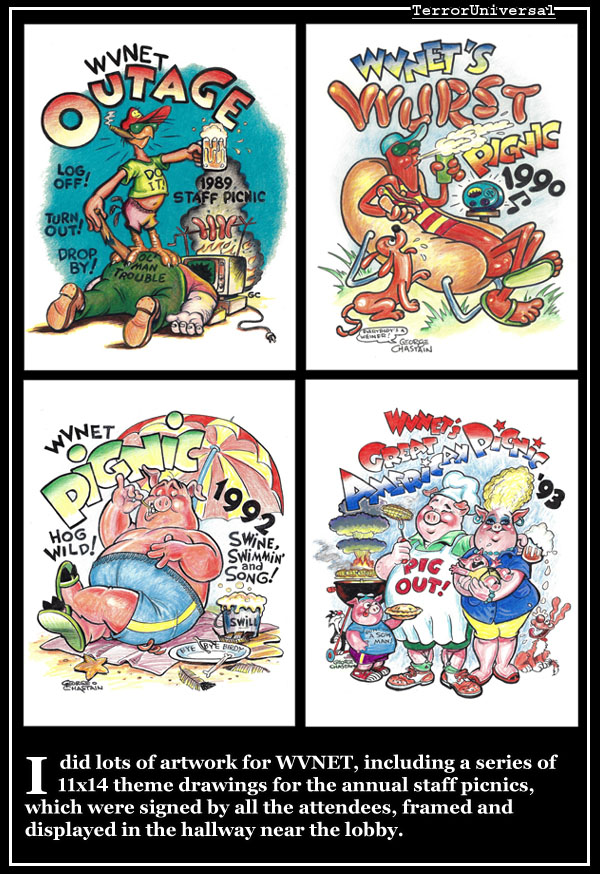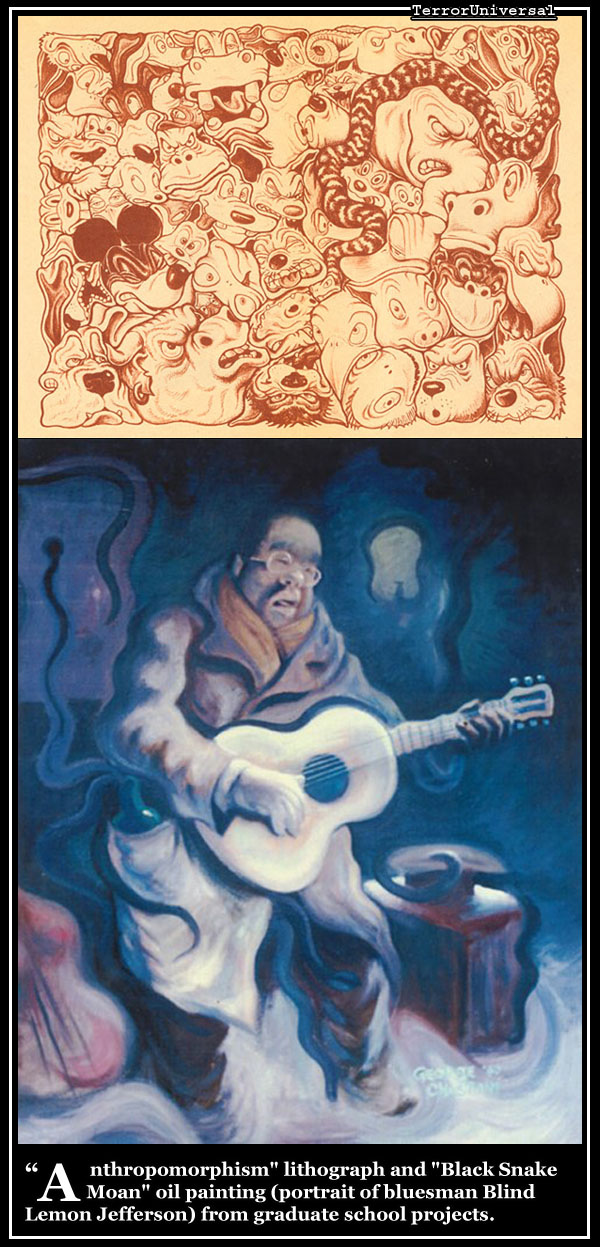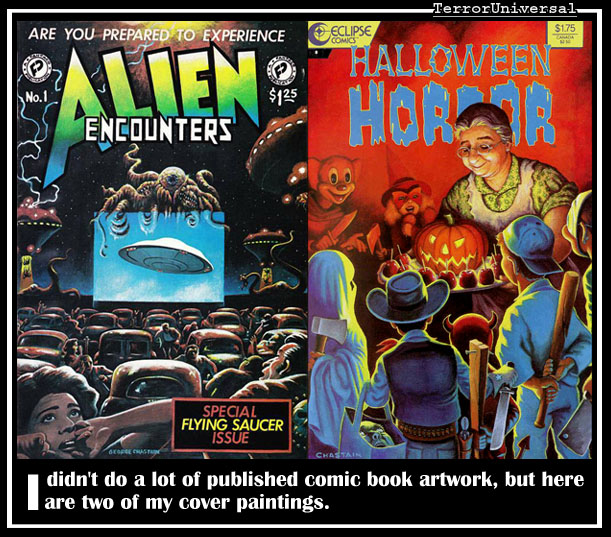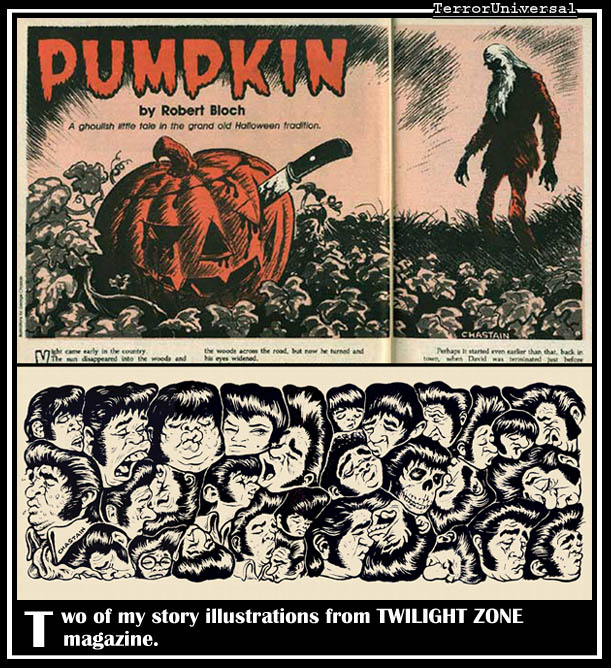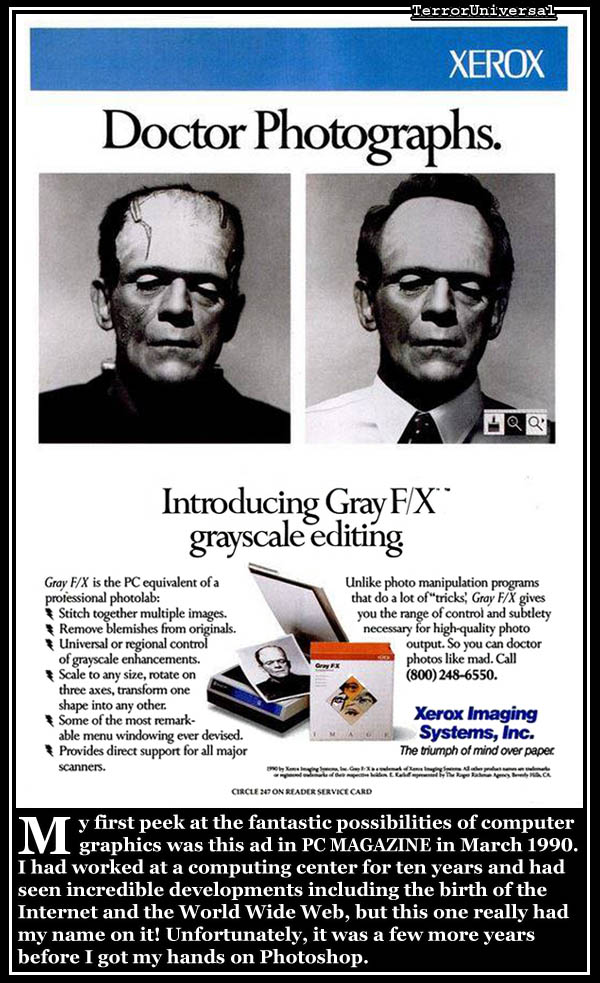 |
 |
|||
|
|
||||
George Chastain
¡Loco por el cine! Mi fascinación por el cine clásico y los realizadores se profundizó tremendamente durante esta época, a veces sin mucho esfuerzo de mi parte, solamente aprovechando las oportunidades doradas que parecían abrirse en mi camino. A principios de 1973, cuando aún vivía con mis padres en nuestra antigua granja familiar, un estudio de Hollywood estaba buscando locación para un film de acción y misterio titulado THE MIDNIGHT MAN (El hombre de la medianoche-1974), acerca de un guardia de seguridad (BURT LANCASTER) en el campus de una universidad del Sur cerca del Clemson College. La casa de mis padres en la cima de la colina, y la antigua granja abandonada de mis bisabuelos fueron escogidas para filmar exteriores en una película en la que también trabajarían CAMERON MITCHELL, SUSAN CLARK, JOAN LORRING, ROBERT QUARRY, ED LAUTER, NICK CRAVAT, MORGAN WOODWARD y varios interesantes actores más. La casa de mis padres sería el hogar del matrimonio compuesto por Mitchell y Lorring y la vieja granja abandonada sería el refugio de una familia de paletos fuera de la ley. Lancaster también era el codirector del film así que, durante una semana, mi familia y varios de mis amigos estuvimos atentos al elenco y al equipo técnico durante las varias secuencias (que también incluían escenas de violencia) que filmaron en nuestras casas y alrededores. about a week. ¡Mi única pena es no haber tenido acceso a Internet en aquella época para chequear los créditos de algunos de estos actores! Si hubiera sabido que ROBERT QUARRY había sido el Conde Yorga, o que JOAN LORRING había sido la novia de Peter Lorre en THREE STRANGERS (Tres extraños-1946), o que el antiguo camarada acróbata de Lancaster, NICK CRAVAT había interpretado al compañero indio de Davy Crockett, Bustedluck, en el Alamo de Disney o que había sido el gremlin que aterrorizaba a William Shatner en cierto famoso episodio de TWILIGHT ZONE (La dimensión desconocida), no les habría dado un minuto de descanso. Pude charlar, sin embargo, con muchos de ellos: recuerdo que Robert Quarry se impresionó de que tuviera el libro de William Everson THE FILMS OF LAUREL & HARDY en mi colección y me expresó admiración por haber conseguido la primera edición norteamericana de THE PHANTOM OF THE OPERA que compré en una tienda de baratijas. Unos veinte años después me lo encontré nuevamente en la convención FANEX en Baltimore y mientras me autografiaba mis fotografías del Conde Yorga, le recordé por pedido de mi madre, cómo le habían gustado los snacks que ella le sirvió, tanto que le había preguntado la receta. Se rió y me contestó de que se convirtieron en un gran éxito entre sus amistades... ¡cuando les agregaba marihuana!
A fines de ese mismo año, me acerqué a un fabuloso cine de reposiciones llamado THE FLICK en Greenville, Carolina del Sur. Uno de los socios de la empresa era amigo mío del colegio y me invitaron a hacer algunos carteles para decorar el lobby; también construí un letrero para la vereda exterior del edificio. Siendo artista residente de The Flick, me sentí más que recompensado por la entrada libre para toda mi familia a cualquier función así que aproveché esta gran oportunidad y me vi docenas de viejos y nuevos clásicos proyectados en la gran pantalla de The Flick. Cada vez que proyectaban un film antiguo se contactaban con una casa de antiguedades de Atlanta especializada en cine para obtener afiches o posters para publicitar las películas. Así que muy a menudo conseguían posters originales o de reestreno por la misma suma que las películas del momento, ya que nadie había exhibido esas mohosas antiguedades en los últimos años. Luego de las proyecciones, me regalaron algunos de esos posters, incluyendo afiches originales de VERTIGO (De entre los muertos-1958), TOUCH OF EVIL (Sombras del mal-1958), THE BLUE DAHLIA (La dalia azul-1946), FORT APACHE (Sangre de héroes-1948), THE THING FROM ANOTHER WORLD (El enigma de otro mundo-1951) y otros clásicos.
Amor y matrimonio Luego que me dieron de baja del Ejército, seguía enamorado de Jeanne, ya que aún nos seguíamos escribiendo, un año después de haberme vuelto de Alemania. Me tomé un tren para ir a verla en Clarion, Pennsylvania, donde estaba criando a sus dos hijos Jason y Dawson, luego de su divorcio. Cuando la volví a ver me di cuenta que éramos el uno para el otro, así que le propuse mudarnos a Carolina del Sur, donde nos casamos en enero de 1974. Mis maravillosos amigos de THE FLICK hicieron arreglos para que la ceremonia se hiciera en la oficina de planta baja mientras arriba se estaba proyectando CASABLANCA (íd-1942). Cuando dábamos el "sí", podíamos oir como cantaban "La Marsellesa" en la película aunque nuestra canción favorita siempre ha sido "Según pasan los años". Luego de la proyección de nuestra película favorita, The Flick cerró sus puertas al público por el resto de la noche en que celebramos nuestra boda junto a los invitados. Y hemos estado felizmente casados por 45 años... y contando.
Jeanne había estudiado bibliotecología en Clarion y consiguió empleo en una gran librería en Greenville... ¡donde CRISWELL firmó ejemplares de sus libros! Mi primer trabajo como hombre casado fue diseñar carteleras publicitarias, trabajo que hice por un salario de esclavos pero en el que adquirí valiosa experiencia acerca de la publicidad y los posters. A veces me inspiraba para mis diseños en mis obras preferidas, por ejemplo personajes de las películas, de la revista MAD, dibujos animados o tiras cómicas de los periódicos. El trabajo de diseño era muy tedioso utilizando medios como témpera, marcadores, tijeras y cola de pegar y letras tipo Letraset sobre plantillas que el equipo de ventas mostraba a los clientes. Hoy en día, con Photoshop, todo habría sido mucho más veloz y eficiente.
Luego de un año dejé el empleo de los avisos publicitarios y conseguí otro como conductor de la biblioteca móvil del condado de Greenville. Otro antiguo amigo del colegio, JIM KENT, también trabajaba en la biblioteca pública y sus tareas incluían la programación de películas para proyectar al público, llegando a dar clásicos como MAD LOVE (Las manos de Orlac-1935), films extranjeros como SEVEN SAMURAIS (Los siete samurais-1954), TOUCH OF EVIL de Orson Welles y muchas otras. Por esa época, Jeanne, los chicos y yo vivíamos en la planta baja de un edificio en cuya planta alta vivían Jim y su novia Cile, que a veces recibían alguna visita que alojaban en un ucarto libre. Ocasionalmente Jim traía a casa el proyector de la biblioteca y las películas que tenía a mano y nos hacíamos un festival particular. Cuando vi por primera vez TOUCH OF EVIL me encantó tanto que la vi tres veces en un solo fin de semana.
De regreso al tablero de dibujo Me sentía tan profundamente vinculado al cine clásico, que la mayor parte de mis ideas para proyectos que tuvieran que ver con el arte provenían de las películas que eran objeto de mi adoración. Creo que mi primer intento serio de crear un afiche para una película imaginaria datan de principios de 1976: una pintura de 40 x 50 cm titulada DRAKULA, parodia de una gran foto del Drácula de Bela Lugosi con un personaje de mi creación, BARRYMORE DUCK, en una pose de vampiro que es tributo a mi artista de comic favorito Carl Barks. Este proyecto comenzó cuando le comenté a Jim Kent acerca de mi idea para el cuadro y él me ofreció comprarme un raro libro de relatos de fantasmas que quería pero no podía conseguir (THE STONEGROUND GHOST TALES de E.G. Swain) si dejaba de hablar y me ponía manos a la obra. Para el momento que terminé la pintura, el libro había sido vendido pero Jim había impreso un centenar de posters del arte original así que tuvimos algo que mostrar en las convenciones de fans que comenzábamos a asistir. La idea original de Barrymore Duck era que había sido una antigua celebridad de muchas películas (en verdad era el hermano perdido de Scrooge McDuck, personaje de Carl Barks). Jim y yo nos reímos mucho imaginando un montón de ideas para las otras películas de Barrymore, y comencé a pintarlo junto a otros personajes de animales en posters de películas imaginarias por supuesto inspiradas en nuestros clásicos favoritos: THE MALTESE MALLARD, SAGEBRUSH (parodia de los westerns clase A), VARMINTS ON HORSEBACK (parodia de los westerns clase B), X (por M de Fritz Lang), THE HOUND (un tributo a Sherlock Holmes), THE THIEF OF QUAKDAD (a Douglas Fairbanks), BRIDE OF FRANKENSWINE, CURSE OF THE HATCHED PEOPLE y otras. También hice un montón de dibujos incluso como boceto preliminar para otras pinturas.
En julio de 1975, Jim y yo asistimos a la ATLANTA COMICS & FANTASY FAIR en Georgia, llevando los posters de DRAKULA, la pintura de THE MALTESE MALLARD que acababa de terminar y una larga tira cómica coloreada a mano titulada UNCLE CTHULHU, una parodia a las historias de horror de H.P. Lovecraft y los personajes de Carl Barks. Allá conocimos al vendedor DON FLANAGAN que le gustó mi trabajo y comenzó a encargarme comisiones de pinturas y a imprimir reproducciones de algunas de mis obras; Don promocionó mis pinturas y, a lo largo de los años, reforzaría mis finanzas.
La siguiente convención que asistimos fue una grande, la NEWCON de Boston, en octubre de 1976, y nos fue requetebien. Por entonces, Rosebud Productions, de Don Flanagan, había impreso mi MALTESE MALLARD como poster color de 50x63 cm y llevé una nueva pintura llamada CURSE OF THE HATCHED PEOPLE que era un extraño tributo a H.P. Lovecraft y las películas de terror de Val Lewton así como también a los personajes de dibujos animados. Dos de mis héroes del comic estaban invitados a esa edición de la NewCon, CARL BARKS y JOHN (Little Lulu) STANLEY, y pude charlar con ellos y logré que me autografiaran lo que hoy son tesoros para mí. Pero mi más fantástico encuentro fue con un joven invitado que ya era una leyenda de la historia de los comics, JIM STERANKO. Le encantaban nuestras ideas e ilustraciones y comenzó a encargarme posters de películas e ilustraciones de tapa para revistas pulp. En 1977 la productora de Jim, Supergraphics, colaboró con Rosebud para publicar un poster color de una de mis pinturas, THE BARX BROS. que caricaturizaba a Groucho, Chico y Harpo Marx como libidinosos patos.
Steranko también me dio una GRAN promoción en el #25 (mayo/junio de 1977) de su publicación MEDIASCENE ("nueva revista americana de entretenimiento popular"), con una de mis parodias pulp en portada, y un artículo satírico de Jim Kent titulado "A Brief Candle: Barrymore Duck and the Cinema of Futility" (con siete ilustraciones de mis dibujos y pinturas embellecidas gráficamente por el mismo Steranko), una lámina central a todo color de la pintura CURSE OF THE HATCHED PEOPLE, un aviso publicitario a toda página de nuestros dos posters a todo color y un muy generoso comentario de Steranko acerca nuestro en la editorial de ese número, elogiando nuestro "espectacular y nuevo concepto del comic animal". ¡Nunca habríamos podido pagar una publicidad así para un público tan específico!
Mudanza a Pennsylvania Alrededor de esta época nos mudamos al norte, a State College, Pennsylvania, donde vivimos varios años en un muy estimulante entorno estudiantil, hice muchos nuevos amigos que eran coleccionistas y fans de la cultura popular, incluyendo a los dueños de comiquerías y disquerías, así como estudiosos que daban cátedras de Artes y Humanidades en la Universidad de Pennsylvania. Jeanne consiguió empleo administrando una librería especializada en libros infantiles y yo me esforzaba tratando de ganar el pan como artista free-lance. Siempre tuve reserva de comisiones, tanto posters de películas como parodias de portadas o de pinturas de Frank Frazetta, pero era duro conseguir que te paguen lo suficiente por ello, y trabajar con velocidad especialmente para mantener una familia.
También hice muchas ilustraciones en blanco y negro a tinta para avisos de periódicos (muchos vinculados a películas) para varias tiendas, y también portadas y tiras cómicas para un dario local. Una de esas tiras, "CasaMelBlanca", se reimprimió en febrero de 1977 en una publicación de alcance nacional, HIGH TIMES, y me pagaron para hacer otra, "The Bantam of the Opera" para el número de abril.
La muy activa comunidad de fans de la ciencia ficción en State College comenzó a celebrar una convención anual llamada PARACON. Uno de los eventos destacables de aquella época fue que salió una segunda convención, BRIDE OF PARACON, que se celebró en mayo de 1979. Los invitados de ese año fueron fabulosos, como por ejemplo invitado de honor THEODORE STURGEON, artista invitado FRANK KELLY FREAS, invitado de honor emeritus JACK CHALKER y mi muy buen amigo PHIL KLASS, que enseñaba lengua en la universidad pero era famoso por sus relatos fantásticos que firmaba con el seudónimo de "WILLIAM TENN". Tenía devoción por las historias de Sturgeon y en persona era muy accesible, un tipo brillante, tal como sus escritos. Frank Kelly Freas era un artista fantástico que hizo la mayoría de mis portadas favoritas de MAD pero era mucho más famoso por sus pinturas e ilustraciones de temas de ciencia ficción. Phil Klass era un hombre maravilloso, cálido amigo que adoraba las películas clásicas tanto como yo. Jack Chalker asistió varias veces a la ParaCon y en 1981 el comité de la convención me comisionó para pintar un pequeño poster paródico como obsequio sorpresa para él: una cruza entre el famoso poster de Amsel para RAIDERS OF THE LOST ARK (Los cazadores del arca perdida-1981), retitulado RAIDERS OF THE WELL OF SOULS (un sarcástico comentario sobre la apropiación de la idea original de las novelas de Chalker por parte de la película) y sustituyendo el rostro de Jack por el de Harrison Ford en el diseño. Me encantó descubrir que Chalker era un gran fan de los comics de Carl Barks para Disney y me encargó la ilustración de la segunda edición de su INFORMAL BIOGRAPHY OF SCROOGE McDUCK, que publicaba con su propia Mirage Press. La primera edición no tenía ilustraciones para evitar probables litigios de Disney por violación de copyright, así que tuve que tener bastante precaución al realizar esa ilustración para no hacer nada remotamente reconocible como ninguna propiedad de Disney. Terminé y entregué el trabajo, me lo pagaron pero, desafortunadamente, el libro nunca se publicó. Años después, luego del fallecimiento de Jack, Eva Chalker encontró la pieza y me la devolvió.
Otra mudanza (a West Virginia) Trabajando en la librería infantil en State College, Jeanne había observado el lugar ideal para abrir su propia librería infantil y finalmente se le dio, en Morgantown, West Virginia, otra ciudad universitaria con una población y una proyección demográfica que parecía la ideal. Encontramos una gran casa antigua para alquilar mientras dábamos un paseo por Morgantown y nos mudamos a fines de 1979. En 1980 PINOCCHIO'S BOOKS & TOYS abrió sus puertas en su primera locación.
Hacer que un negocio reditúe toma largo tiempo, mucho planeamiento, trabajo duro y SUERTE y mis encargos como artista freelance no sumaban lo necesario. Todavía tenía muchas comisiones y tantos trabajos publicitarios como podía tomar pero no alcanzaba para cubrir los gastos y Jeanne tuvo que destinar la mayor cantidad de dinero que pidió para arrancar la librería. Afortunadamente uno de sus mejores clientas era la gerente de servicio informático d ela WVNET (West Virginia Network for Educational Telecomputing), el centro de estudios de computación más importante del estado en Morgantown y estaba en la búsqueda de un artista especializado para trabajar allí. Adoraba los avisos publicitarios que había confeccionado para la librería de Jeanne así que en 1980 pedí empleo full time como artista y, a pesar de que jamás había tocado el teclado de una computadora, lo conseguí. A lo largo de los años aprendí un montón trabajando con computadoras y mi trabajo mejoró monetariamente al convertirme en editor técnico y desarrollador web. Poco después de haber sido desarrollados, también aprendí a usar programas de computadora que se convirtieron en herramientas esenciales para los artistas comerciales de hoy. Trabajé en WVNET por más de 23 años antes de pedir retiro voluntario para cuidar a mi anciana madre en South Carolina y dedicarme nuevamente a los proyectos freelance.
Las funciones creativas de mi hemisferio cerebral derecho no se desactivaron por completo durante todos esos años de empleo diario; hice un montón de diseños durante ese período, tanto para WVNET como freelance. Apenas nos mudamos a Morgantown había solicitado inscripción en un programa de la Universidad de West Virginia, a ver si podía aprovechar el último par de años en el ejército. Me especialicé en pintura y grabado y obtuve un título de grado en dos años mientras trabajaba de tiempo completo en WVNET.
En tanto, había estado haciendo ilustraciones para la editora BYRON PREISS VISUAL PUBLICATIONS, y a lo largo de varios años, hice trabajos para publicaciones masivas de Byron como THE BEACH BOYS: THE AUTHORIZED BIOGRAPHY (1979), una pintura color para ilustrar su tema "Country Air", THE SECRET LIVES OF CATS (1982), pintura de la oficina de un detective felino y varias más, pero lo mejor fue la excitante oportunidad de trabajar con mi héroe de la infancia HARVEY KURTZMAN (creador de MAD y LITTLE ANNIE FANNY de Playboy) en ocasión de que era el supervisor de una publicación de BPVP llamada NUTS! Me aportó algunos excelentes consejos en la parodia de ciencia ficción en la que estaba trabajando junto al guionista Mel Gilden titulada "In Space, Nobody Can Hear You Quack" (En el espacio nadie escuchará tu cuak). Me arrepiento de haber sido tan temeroso y no preguntarle si podía mandarle uno de los muchos tesoros de Kurtzman de mi colección para un autógrafo!
Hice portadas de algunos comic book: ALIEN ENCOUNTERS #1 (Fantaco Publications, enero 1981), HALLOWEEN HORRORS #1 (Eclipse Comics, octubre 1987), y tres publicaciones de Shanda Fantasy Arts: SWORD OF THE FOX (2005), GIANT SHANDA ANIMAL #11 and KATMANDU #3 (2006).
El escritor T.E.D. KLEIN me contrató para ilustrar tres historias publicadas en la revista TWILIGHT ZONE de la que él era editor: "The Great Elvis Presley Look-Alike Murder Mystery" de Mick Farren (número de octubre de 1981), "The Ash Tree" de mi autor favorito de relatos de fantasmas M.R. James (diciembre de 1981), y "Pumpkin," un relato de Halloween de Robert "PSYCHO" Bloch (diciembre de 1984). Unos años atrás, en la World Fantasy Convention, había conocido en persona a Robert Bloch y lo volví a ver en la fabulosa convención de Famous Monsters en Arlington, Virginia, en 1993. Le hice autografiarme una fotografía de Janet Leigh gritando en la ducha y me dijo que debía conseguir el autógrafo de ella también, cosa que logré más tarde... pero no se me ocurrió mencionarle que había ilustrador su gran relato de terror en TWILIGHT ZONE. ¡Qué tonto fui!
En 1982 fue contratado por KIRBY McCAULEY, por aquella época representante de Stephen King, para hacer una serie de pinturas acerca de los varios monstruos y escenas de horror en la novela "The Mist" que pudiera ser útil a los técnicos de Hollywood para la creación de los efectos especiales de una película basada en aquella historia. Tuve que realizar esas pinturas con suma premura, trabajando de noche y durante los fines de semana durante un mes. En cierto momento no me quedaba muy clara la descripción de uno de los monstruos gigantes de King, así que Kirby me pasó su número telefónico, lo llamé y me dio una mejor idea acerca de lo que tenía en mente. Hice todas las pinturas, Kirby voló a Morgantown, recogió las obras en una hamburguesería, me abonó generosamente y de inmediato se subió a un avión. Nunca supe qué ocurrió con aquel proyecto, pero la historia de King no llegaría a la gran pantalla hasta que Frank Darabont la filmó en 2007. Debió haber sido mucho más sencillo y barato crear aquellos monstruos imaginarios con CGI.
Mi carrera artística realmente se puso a rodar en los años '90, especialmente a fines de aquella década, luego de la llegada de Internet, la World Wide Web, los nuevos medios de publicación, las copiadoras digitales a color y programas gráficos como el Photoshop.
Nota del editor: Este artículo continuará... No dejen de visitar la George Chastain Facebook Timeline para ver su portfolio de ilustraciones y composiciones sobre monstruos del cine clásico de horror.
Movie Madness! My lifelong fascination with classic films and filmmakers deepened tremendously during this period, often with little effort on my part, since golden opportunities just seemed to fall in my path! Early in 1973, when I was still living with my Mom and Dad on our old family farm property, a Hollywood movie company was scouting locations for a mystery/action film called THE MIDNIGHT MAN, about a security guard (BURT LANCASTER) on a southern university campus based on nearby Clemson College. My parents' hilltop home, and my great-grandparents' big abandoned farmhouse on family property nearby, were selected as locations for the film, which also starred CAMERON MITCHELL, SUSAN CLARK, JOAN LORRING, ROBERT QUARRY, ED LAUTER, NICK CRAVAT, MORGAN WOODWARD and a number of other very interesting actors. My parents' house served as the home of the married couple played by Mitchell and Lorring, and the old abandoned farmhouse a quarter-mile away was used as the hideout of a family of hillbilly outlaws. Lancaster also co-directed the film, and my family and a few of my friends got to watch the cast and crew filming various sequences (including violent action scenes) in and around our family homes for about a week. My only regret is that I didn't have Internet access back then to check on the credits of some of these actors! If I had known that ROBERT QUARRY was COUNT YORGA, or that JOAN LORRING had played Peter Lorre's girlfriend in THREE STRANGERS, or that Lancaster's old acrobat partner NICK CRAVAT had played Davy Crockett's Indian companion "Bustedluck" at Disney's Alamo AND the Gremlin who freaked William Shatner out in that TWILIGHT ZONE episode, I wouldn't have given them a moment's rest! I did get to talk with many of them though: I remember Robert Quarry being impressed that I had William Everson's FILMS OF LAUREL & HARDY in my book collection, and he admired the 1st American edition of THE PHANTOM OF THE OPERA I found in a junk store. About 20 years later I met him again at the Fanex convention in Baltimore, and while he was signing my Count Yorga photos, I reminded him (at my Mom's request) that he had liked one of the snacks she served to the movie folks so much that he asked her for the recipe. He laughed and told me that it was a big hit with his friends when he added marijuana to it!
Later that same year, I was involved with a fabulous revival movie theater called THE FLICK in Greenville, South Carolina. One of the partners in the enterprise was a friend from college, and I was invited to do some movie-related artwork to decorate the lobby, and I built and fiberlassed a big plywood sign for the outside of the building. Since I was The Flick's resident artist, I was more than compensated for my work by free admission for my whole family to any movies I attended, and I took advantage of this great opportunity to see dozens of old and new film classics projected on The Flick's big screen. Whenever they showed a vintage film, they contacted an ancient movie paper house in Atlanta to obtain any related posters still stored there, and they often got original or vintage re-release posters for the same low rate as posters for new films, since nobody had shown the moldy oldies for many years. They gave me some of those posters after the film was shown, including original release posters from VERTIGO, TOUCH OF EVIL, THE BLUE DAHLIA, FORT APACHE, THE THING FROM ANOTHER WORLD and other classics!
Love and Marriage After I got out of the Army I was still infatuated with Jeanne, and we were still writing to each other more than a year after I came home from Germany. I took a train to visit her in Clarion, Pennsylvania, where she was attending college and raising her little boys Jason and Dawson after her divorce. When I saw her again I knew she was the one for me, so I talked her into moving to South Carolina, where we got married in January 1974. My wonderful friends at THE FLICK arranged for us to be married there in a private ceremony in the business office downstairs, during a public showing of CASABLANCA upstairs! We could hear "La Marseillaise" being sung in the film as we exchanged our vows, but "As Time Goes By" has always been "our song." After the showing of our favorite film, The Flick was closed to the public for the evening while our marriage was celebrated with a wedding party for invited guests. We've been happily married for 45 years now (so far, so good).
Jeanne had studied library science at Clarion, and she got a job working in a big book store in Greenville...CRISWELL did a book signing while she worked there! My first job as a married man was designing billboards, where I worked for slave wages but got lots of experience designing advertising posters. Sometimes I based my designs on artwork I liked, including characters from movies, MAD magazine, animated cartoons and classic newspaper strips. The design work was very tedious, using time-consuming media like tempera paint, magic markers, scissors and rubber cement and presstype lettering on paper billboard templates the sales team showed to clients. I'd like to have another crack at a job like that now--Photoshop would be a much faster and more efficient way to do it.
I quit the billboard job after a year, and got another one as a Bookmobile driver for the Greenville County Library system. Another college friend, JIM KENT, also worked in the downtown library; his job included scheduling films that were shown to the public, including classic horrors like MAD LOVE, foreign films like Kurosawa's SEVEN SAMURAI, Orson Welles' TOUCH OF EVIL, and many others. Around this time Jeanne and I and our kids were living downstairs in a big communal house in Greenville; Jim and his girfriend Cile lived upstairs, sometimes with another friend crashing in a spare room. Occasionally Jim brought home a library projector and movies from the current film series and we had our own movie festivals. When I first saw TOUCH OF EVIL I loved it so much that I watched it three times in one weekend.
Back to the Drawing Board Meanwhile, since my life was so deeply involved with old movies, most of my ideas for art projects were based on the movies I loved. I think my first serious attempt to create a poster for an imaginary film was early in 1976: a 16"x20" stipple & ink wash painting called DRAKULA, spoofing another great DRACULA photo of Bela Lugosi, but substituting a character I created, BARRYMORE DUCK, in the vampire's pose as a tribute to my favorite comic artist Carl Barks. This project began when I told Jim Kent my idea for the piece, and he offered to buy me a rare book of ghost stories I wanted but couldn't afford (E.G. Swain's THE STONEGROUND GHOST TALES) if I'd stop talking about it and do it! By the time I finished the painting the book had been sold, but Jim had a hundred posters printed from the original art so we would have something to show at the fan conventions we had started to attend. My original concept of Barrymore Duck was that he was a once-famous actor who had starred in many classic films in his heyday (and secretly, was the long-lost brother of Carl Barks' Scrooge McDuck!). Jim and I had lots of laughs dreaming up ideas for Barrymore's other films, and I started painting Barrymore and other funny animal characters in posters for imaginary films based on some of our reel favorites: THE MALTESE MALLARD, SAGEBRUSH (spoofing A-westerns), VARMINTS ON HORSEBACK (B-westerns), X (Fritz Lang's M), THE HOUND (Sherlock Holmes), THE THIEF OF QUAKDAD (Douglas Fairbanks), BRIDE OF FRANKENSWINE, CURSE OF THE HATCHED PEOPLE and others. I also did a lot of drawings of this sort, both as preliminary roughs for paintings and finished statements.
Jim and I attended the ATLANTA COMICS & FANTASY FAIR in Georgia in July 1975, bringing the DRAKULA posters, THE MALTESE MALLARD painting I had recently finished, and a large hand-colored comic strip called UNCLE CTHULHU spoofing H.P. Lovecraft horror stories and Carl Barks' characters. We met dealer DON FLANAGAN there, who liked my work and began to commission paintings and produce reproductions of some of them; Don promoted my artwork and enhanced my finances in various ways for years to come.
The next comic convention we attended was a major one, NEWCON in Boston in October 1976, and we scored BIG there. By then Don Flanagan's Rosebud Productions had reproduced my MALTESE MALLARD painting as a 20"x25" color poster, and I had brought along a new painting called CURSE OF THE HATCHED PEOPLE that was a twisted tribute to H.P. Lovecraft, Val Lewton horror films, and vintage animated cartoon characters. Two of my childhood comic book heroes were major NewCon guests that year, CARL BARKS and JOHN (Little Lulu) STANLEY, and I talked to both of them and got them to autograph some treasures for me! But an even more fantastic meeting was with a younger guest who was already a legend in the history of comics, JIM STERANKO! He loved our ideas and artwork, and he began to commission movie poster and pulp magazine cover paintings, and Jim's Supergraphics production company collaborated with Rosebud in 1977 to publish another color poster of my painting THE BARX BROS., which caricatured Groucho, Chico and Harpo Marx as lustful ducks.
Steranko also gave us HUGE promotion in issue #25 (May-June 1977) of his publication MEDIASCENE ("America's New Magazine of Popular Entertainment"), with one of my pulp parodies on the cover, Jim Kent's satirical article called "A Brief Candle: Barrymore Duck and the Cinema of Futility" (illustrated with 7 of my drawings and paintings and Steranko's own graphic embellishments), a full-color centerspread of the CURSE OF THE HATCHED PEOPLE painting, a full-page ad for our two full-color posters, and Steranko's very generous comments about us in his editorial for the issue, noting our "spectacularly different concept in funny animal art." We couldn't BUY publicity like that for our target audience at any price!
A Major Move (to Pennsylvania) Around this time my family had moved north to State College, Pennsylvania, where we lived for several years in a very stimulating college environment, and I made many new friends who were fellow collectors and pop culture fans, including the owners of comic book shops and records stores, and serious scholars who taught Arts & Humanities courses at Penn State. Jeanne got a job managing a children's book store and I was trying hard to make a living as a free-lance artist. I always had a backlog of artwork commissions, including movie poster and pulp cover spoofs and parodies of Frank Frazetta paintings, but it was hard to get paid enough, and work fast enough, to support a family.
I was also doing a lot of B&W ink drawings including newspaper ads (many of them movie-related) for various stores, and covers and comic strips for a local underground newspaper. One of those satirical strips, "CasaMelBlanca," was reprinted in the February 1977 issue of the national publication HIGH TIMES, and I was paid to do another one, "The Bantam of the Opera." for the April issue.
The very active science fiction community in State College started hosting an annual convention called PARACON around the time we moved to town. One of the highlights of our time there was the second convention, BRIDE OF PARACON, held in May 1979. The guests that year were fabulous, including Guest of Honor THEODORE STURGEON, Guest Artist FRANK KELLY FREAS, Guest of Honor Emeritus JACK CHALKER and my good friend PHIL KLASS, who taught in the Penn State English department but was famous for the fantastic stories he wrote as "WILLIAM TENN." I had loved reading Sturgeon's short stories for many years, and he was as brilliant and accessible in person as his writing. Frank Kelly Freas was a fantastic artist who painted many of my favorite MAD covers but was even better known for his sci-fi paintings and illustrations. Phil Klass was a warm, wonderful man who loved old movies as much as I do, and he visited our home a number of times. Jack Chalker attended ParaCon several times, and in 1981 the convention committee commissioned me to paint a small movie poster parody as a surprise gift for him: a twist on the famous Amsel poster for RAIDERS OF THE LOST ARK, retitled RAIDERS OF THE WELL OF SOULS (a wry comment on the film's appropriation of Chalker's original use of the concept in his novels), and substituting Jack's face for Harrison Ford's in the design. I was delighted to discover that Chalker was a big fan of Carl Barks' Disney duck comics too, when he commissioned me to illustrate the 2nd edition of his INFORMAL BIOGRAPHY OF SCROOGE McDUCK, to be published by his own Mirage Press. The first edition had no illustrations to avoid prosecution by Disney for copyright infringement, so I had to be very careful about making anything in the artwork remotely recognizable as Disney property. I managed to complete the assignment and was paid for it, but unfortunately the book was never published! Years later, after Jack died, Eva Chalker found the artwork and returned it.
Another Major Move (to West Virginia) While managing the book store she worked at in State College, Jeanne had been scouting a likely location for opening her own children's book store for a long time, and she finally settled on Morgantown, West Virginia, another university town with a population and projected growth that seemed to be ideal. We found a big old house to rent within walking distance of Morgantown's downtown shopping area, and we moved there in late 1979. PINOCCHIO'S BOOKS & TOYS opened in its first location early in 1980.
It takes a long time, lots of planning and management, hard work and LUCK to make a small business successful, and I wasn't making enough money with my freelance art to help as much as I wanted to. I was still doing a lot of commissioned artwork, and as much local advertising work as I could get (including free ads for Pinocchio's), but I just wasn't making enough to cover our household expenses, and Jeanne had to put most of the money she took in at the store back into the business to get it started. Fortunately, one of her best customers was the Information Services manager at the West Virginia Network for Educational Telecomputing (WVNET), the state higher educational computing center in Morgantown, and she was looking for an artist and publications specialist to work there. She loved the ads I did for Jeanne's store, so I applied for that full-time job as staff artist and got it--even though I had never even touched a computer keyboard in 1980. I learned a lot about working with computers over the years, and my job developed into a better paying position as a technical editor and web developer. Soon after they were developed, I also learned to use computer programs that have become essential tools for many commercial artists today. I worked at WVNET for more than 23 years before I took an early retirement to take care of my elderly Mom in South Carolina, and to devote myself to freelance art projects again.
My right-brain creative functions hadn't completely shut down all those day job years--I did lots of design projects during that period, both for WVNET and as a free-lance artist. When we first moved to Morgantown I applied for admission to the graduate school Masters degree program at West Virginia University, taking advantage of the last couple of years of the G.I. Bill benefits I was entitled to after I got out of the Army. I majored in painting and minored in printmaking, and earned my Masters degree in two years while working the fulltime job at WVNET.
Meanwhile, I had been doing artwork for the ground-breaking publishing enterprise BYRON PREISS VISUAL PUBLICATIONS, and over the next few years I did illustrations for Byron's mainstream publications like THE BEACH BOYS: THE AUTHORIZED BIOGRAPHY in 1979 (a color painting illustrating their song "Country Air"), THE SECRET LIVES OF CATS in 1982 (a painting of a feline hardboiled detective's office), and other interesting assignments--best of all was the golden opportunity to work with my childhood hero HARVEY KURTZMAN (creator of MAD and Playboy's LITTLE ANNIE FANNY) when he was the supervising editor of BPVP's humorous paperbacks called NUTS! He gave me some good guidance on the sci-fi movie parody I was working on with writer Mel Gilden called "In Space, Nobody Can Hear You Quack." I regret that I was too awe-struck to ask if I could send him one of the many vintage Kurtzman treasures in my collection for an autograph!
I painted a few comic book covers starting back then: ALIEN ENCOUNTERS #1 (Fantaco Publications, January 1981), HALLOWEEN HORRORS #1 (Eclipse Comics, October 1987), and three published by Shanda Fantasy Arts: SWORD OF THE FOX (2005), GIANT SHANDA ANIMAL #11 and KATMANDU #3 (2006).
Writer T.E.D. KLEIN hired me to illustrate three stories published in TWILIGHT ZONE magazine when he was the editor: "The Great Elvis Presley Look-Alike Murder Mystery" by Mick Farren (October 1981 issue), "The Ash Tree" by my favorite ghost story writer M.R. James (December 1981), and "Pumpkin," a Halloween story by Robert "PSYCHO" Bloch (December 1984). I had met Robert Bloch a few years earlier at the World Fantasy Convention, and I met him again at the fabulous Famous Monsters Convention in Arlington, Virginia in 1993. I got him to sign a closeup of Janet Leigh screaming in the shower, and he said I should get her to sign it too, which I managed to do later--but I didn't think about mentioning that I had illustrated his great horror story in TWILIGHT ZONE! Stupid! Stupid! STUPID!
In 1982 I was hired by KIRBY McCAULEY, Stephen King's agent at the time, to do a series of paintings visualizing various monsters and horror scenes in King's novella "The Mist" that would be used as an aid for Hollywood technicians creating the special effects in a film based on King's story. I had to produce all the paintings very quickly, knocking them out at night after work and on weekends for about a month. At one point I didn't get a clear picture of one of King's giant monsters from his description, so Kirby gave me his private number, I called him up and he gave me a better idea of what he had in mind. When all the paintings were done, Kirby flew into Morgantown's tiny airport, picked the paintings up at a nearby burger joint, paid me handsomely for the artwork, and took off again immediately. I never heard what happened to the project, but King's story never reached the big screen until Frank Darabont filmed it in 2007. It must have been a lot easier and cheaper to create King's imaginary monsters with CGI.
My art career really got rolling in the '90s, especially later in the decade, after the arrival of the Internet, the World Wide Web, desktop publishing, digital color copiers and graphics packages like Photoshop.
Editor's Note: This article to be continued... Don't forget to visit George Chastain Facebook Timeline and see his portfolio of classic movie horror artwork.
| atrás | recomendar esta página | enviar comentarios | arriba | |
© 2025 Terror Universal |


